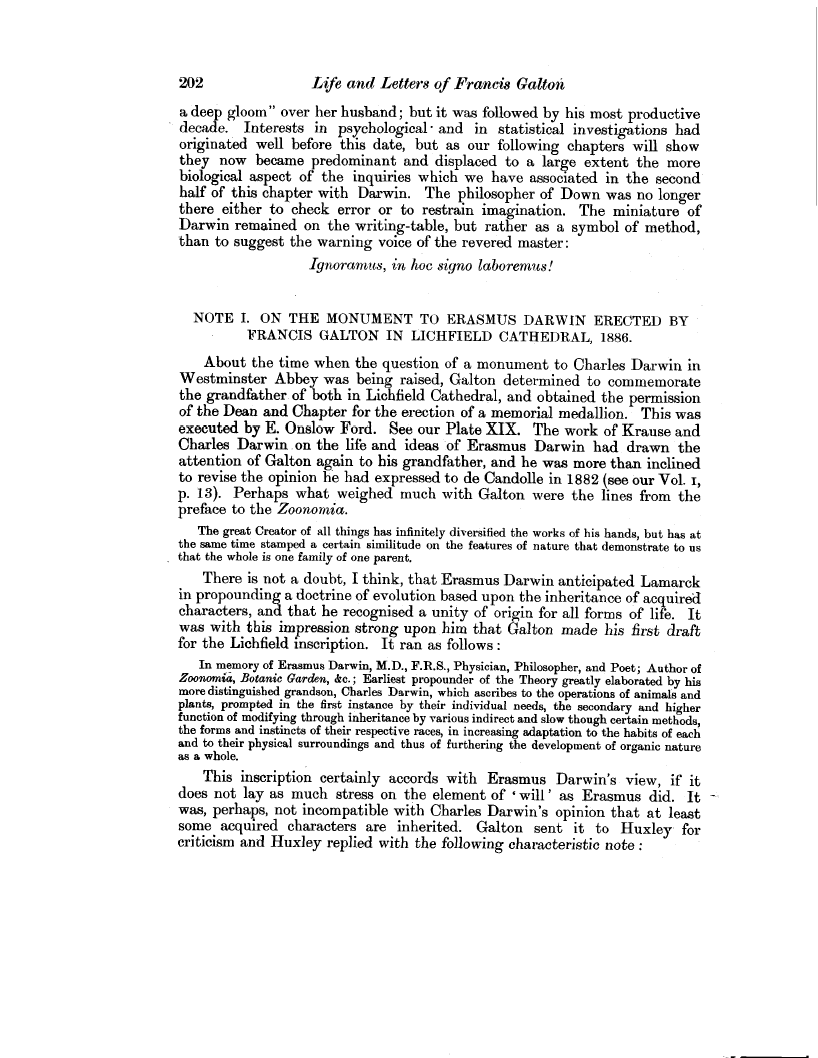202 Life and Letters of Francis Galton
a deep gloom" over her husband; but it was followed by his most productive decade. Interests in psychological -and in statistical investigations had originated well before this date, but as our following chapters will show they now became predominant and displaced to a large extent the more biological aspect of the inquiries which we have associated in the second half of this chapter with Darwin. The philosopher of Down was no longer there either to check error or to restrain imagination. The miniature of Darwin remained on the writing-table, but rather as a symbol of method, than to suggest the warning voice of the revered master:
Ignoramus, in hoc signo laboremus!
NOTE I. ON THE MONUMENT TO ERASMUS DARWIN ERECTED BY
FRANCIS GALTON IN LICHFIELD CATHEDRAL, 1886.
About the time when the question of a monument to Charles Darwin in Westminster Abbey was being raised, Galton determined to commemorate the grandfather of both in Lichfield Cathedral, and obtained the permission of the Dean and Chapter for the erection of a memorial medallion. This was executed by E. Onslow Ford. See our Plate XIX. The work of Krause and Charles Darwin. on the life and ideas of Erasmus Darwin had drawn the attention of Galton again to his grandfather, and he was more than inclined to revise the opinion he had expressed to de Candolle in 1882 (see our Vol. i, p. 13). Perhaps what weighed much with Galton were the lines from the preface to the Zoonomia.
The great Creator of all things has infinitely diversified the works of his hands, but has at the same time stamped a certain similitude on the features of nature that demonstrate to us that the whole is one family of one parent.
There is not a doubt, I think, that Erasmus Darwin anticipated Lamarck in propounding a doctrine of evolution based upon the inheritance of acquired characters, and that he recognised a unity of origin for all forms of life. It was with this impression strong upon him that Galton made his first draft for the Lichfield inscription. It ran as follows
In memory of Erasmus Darwin, M.D., F.R.S., Physician, Philosopher, and Poet; Author of Zoonomia, Botanic Garden, &c.; Earliest propounder of the Theory greatly elaborated by his more distinguished grandson, Charles Darwin, which ascribes to the operations of animals and plants, prompted in the first instance by their individual needs, the secondary and higher
function of modifying through inheritance by various indirect and slow though certain methods, the forms and instincts of their respective races, in increasing adaptation to the habits of each and to their physical surroundings and thus of furthering the development of organic nature as a whole.
This inscription certainly accords with Erasmus Darwin's view, if it does not lay as much stress on the element of ' will' as Erasmus did. It was, perhaps, not incompatible with Charles Darwin's opinion that at least some acquired characters are inherited. Galton sent it to Huxley for criticism and Huxley replied with the following characteristic note

